Some additional observations (see Jim Hamilton’s take, as well as others) on the GDP release: (1) the five year revision indicates that GDP was larger than we thought, but it also declined faster in 2009Q1; (2) GDP growth was lower throughout 2008 than earlier estimated; (3) GDP growth in 2008Q2 at 1.5% SAAR would have likely been at zero or negative in the absence of the January 2008 stimulus package in which case; (4) GDP q/q growth would have been negative from 2008Q1 to 2009Q2; (5) the case that ARRA directly affected 2009Q2 GDP is limited, in a mechanical sense since most of the increase in government spending is accounted for by defense spending; and (6) the US ex-oil ex-agricultural net exports to GDP ratio is back to where it was in 1998Q1.
Just a recap: the -1% GDP q/q SAAR growth came in above the -1.6% growth predicted in the early-July WSJ survey (see here), but below the Bloomberg consensus of -0.7% reported a few days before the release.
The log level of GDP, as reported in the final 2009Q1 and advance 2009Q2 releases, is depicted in Figure 1. According to the revisions, GDP is now 4% lower than a year ago, in log terms. This is the largest recorded year-on-year percentage decline in GDP in the post-War period.
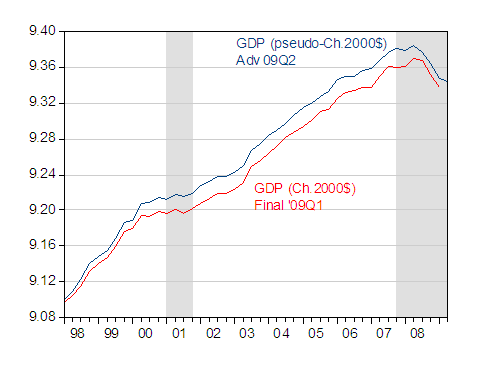
Figure 1: Log GDP in pseudo-Ch.2000$ SAAR from 09Q2 advance (dark blue), log GDP in Ch.2000$ from 09Q1 final (red). NBER defined recession dates shaded gray. GDP in Ch.2005$ converted to Ch.2000$ using ratio of GDP deflators in 2005. Source: BEA 2009Q2 advance GDP release and 2009Q1 final release, NBER and author’s calculations.
GDP larger pre-recession, but shrinking faster in 09Q1
Note that the BEA changed the units in which it measured real output, from Chained 2000 dollars to Chained 2005 dollars. In order to get them in comparable units, I adjusted the series in Ch.2005$ by the difference in deflators between 2005 and 2000. Hence, this is an ad hoc adjustment, which does not fully account for the many differences (see the GDP release for details, as well as NYT).
The major reason why real GDP is higher than earlier estimated is because nominal GDP is higher.
Notice further that while GDP only declined by 1% SAAR in 2009Q2, 2009Q1 GDP growth was revised downward. These revisions are shown in Figure 2.
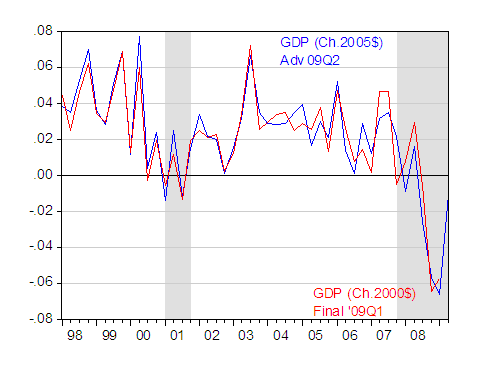
Figure 2: Quarter on quarter annualized growth rates of GDP in Ch.2005$ (blue), of GDP in Ch.2000$ (red). Growth rates calculated as log first differences. NBER defined recession dates shaded gray. Source: BEA 2009Q2 advance GDP release and 2009Q1 final release, NBER and author’s calculations.
The Bush stimulus
With the exception of 08Q2, q/q growth has been negative since 08Q1. Even 08Q2 q/q SAAR growth was only 1.5 ppts. A CBO analysis of the impact of the January 2008 stimulus package indicated that consumption growth was raised about 2.3 ppts in 08Q2. Since consumption is about 70 percent of GDP, then — holding all else constant — then GDP growth was about 1.6 ppts higher (of course, not all else was held constant, but this is good enough for back-of-the envelope). Hence, in the absence of the stimulus, growth would have likely been near zero in 08Q2.
Beware revisions
Let me observe that GDP is a number subject to numerous revisions, and people who make definitive pronouncements about the state of the economy based on advance releases of GDP around likely turning points (case in point discussed here) are likely to be embarrassed in the future. This applies to both maxima and minima; troughs will likely be re-assessed in the future as well. These comprehensive revisions also highlight why the NBER BCDC focuses on four other variables above and beyond GDP.
The impact of ARRA in 09Q2
In terms of contributions to growth, there’s been some discussion of how the stimulus package has, or has not, had an impact on 2009Q2 growth. In mechanical terms, it’s hard to see an impact. First, as indicated in this post, the cumulative amount spent through June 2009 was only about $60 billion. Second, according to the NIPA definition of spending on goods and services, very little of the growth can be accounted for by Federal nondefense spending [1].
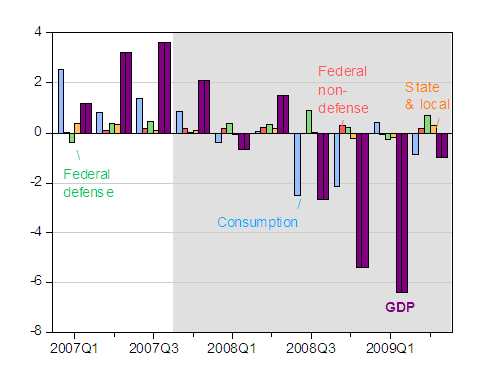
Figure 3: Growth rate of GDP in Ch.2005$ (dark purple thick bar), contribution from consumption (light blue bar), from Federal nondefense spending (dark orange bar), Defense spending (light green bar) and state and local government spending (light orange bar), all in percentage points. NBER defined recession dates shaded gray. Source: BEA 2009Q2 advance GDP release, and NBER.
Even state and local government spending only contributes slightly to growth. I have two caveats here. First, working in the mechanical sense, while state and local spending only contributed a small positive amount (0.3 ppts) in 2009Q2, this is a reversal from 2009Q1 when state and local spending was deducting 0.2 ppts from growth. In the absence of the stimulus bill, state and local spending might very well have continued to deduct from growth, as states were forced to balance budgets. (Of course consumption could have been higher than it otherwise would have been, due to tax rebates; see below.*)
Accounting is useful, but it’s important to recall Figure 3 presents only an accounting decomposition. Intertemporal considerations come into play, to the extent that households, anticipating higher future income than would otherwise would have occurred. State and local governments probably kept some projects running, rather than shutting them down, with knowledge that funds would be coming in. I don’t want to overstress these channels, but the intertemporal perspective is, in any case, the hallmark of the New Classical approach. (In my view, this effect is likely to be large only if one is a believer that the intertemporal rate of substitution is large and liquidity constraints minor, and I’m not quite ready to go so “New Classical”). I expect the biggest impacts to be in the future (and I, like the CBO, expect those effects to be noticeable).
Tracking trade
The trade balance still seems to be improving, either overall, or when excluding agricultural exports and oil imports. In fact, the latter is back to the levels of 1998Q1.
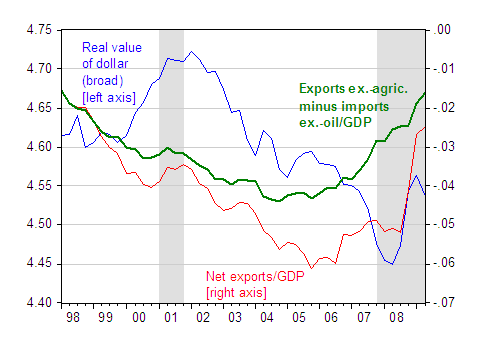
Figure 4: Real value of dollar against a broad basket of currencies (blue, left axis), net exports to GDP (red, right axis) and exports ex.-agric minus imports ex.-oil to GDP (green, right axis). NBER defined recession dates shaded gray. GDP Source: BEA 2009Q2 advance GDP release, NBER and author’s calculations.
That being said, real goods imports (ex.-oil) and exports (ex.-agric.) are still decreasing, albeit at slower rates than before [2]. The reported values for 2009Q2 are based upon only two months’ worth of data, so we’ll have to wait until the preliminary release for a better fix on where trade volumes are going.
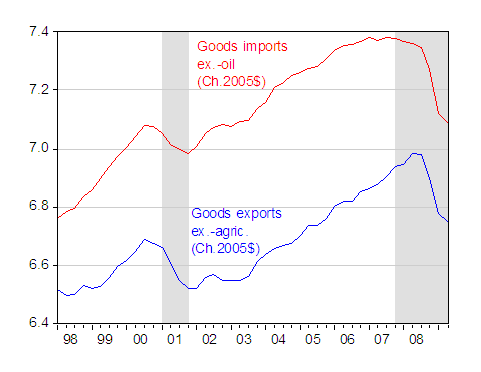
Figure 5: Log exports ex.-agricultural goods in Ch.2005$ (blue) and log imports ex.-oil (red). NBER defined recession dates shaded gray. Source: BEA 2009Q2 advance GDP release, NBER and author’s calculations.
Since exports are still declining, they are deducting (mechanically) from the components of growth. I’ve viewed the sharp drop in trade volumes as a function of sharply declining world output combined with high income elasticities (perhaps due to vertical specialization) and a credit crunch [3], [4]; in contrast Freund believes that the dropoff is explicable in terms of elasticities. How fast trade volumes bounce back depends upon the importance of each factor, and the pace of resolution of the credit crunch [5].
* [Update 5:51pm Pacific: Here’s a way to think about what the impact of ARRA has been on 2009Q2 growth. About $60 billion of stimulus funds had been expended by end-June, of which a large portion is in the form of tax rebates. The price deflator is about 10% higher in 2009Q2 than in 2005, so $60 billion translates to about 54.5 billion 2005$. This is a cumulative figure, while 2009Q2 SAAR GDP was 12892 billion, or 3223 billion Ch.2005$ at quarterly rate. If the multiplier is 0.5 (keeping in mind a large chunk of these funds are tax rebates), then growth was about 3 percentage points higher (q/q SAAR) than would have otherwise occurred; I think this is how Josh Bivens arrived at the conclusion that GDP growth would have been 3% lower in the absence of the ARRA.
GDP larger pre-recession
I’m not sure there’s a meaningful way to compare levels pre- and post-revisions. In fact, if you compare average growth rates over various horizons (I believe these comparisons are more meaningful), the GDP growth was revised downward since at least 2000. In other words, whatever the levels are, growth has been revised down this entire decade.
Jim Kahn: I don’t see why not. Both nominal and real (when rebasing real GDP) are larger post-revision than pre-revision in the period before the 2007- recession. I agree there have been many downward revisions, but this is a substantive and comprehensive revision (one that occurs only every five years). Over the 2000-05 period the difference in nominal GDP is about 1.5 percent.
Can you comment on the spike down in the deflator from 1`.9 to 0.2. Seems to me that is why the bond market rallied. IS this a fucntion of the adjustment. They claim iupfront that the gross domestic purchases index climbed 0.7% of so. But the deflator was 0.2. Why is it that no one is focusing on the spike down in the deflator? Obviously the report is filled with holes but this stiukc out to me as yet another metric which seems skewed.
Maybe I’m misunderstanding what you did, but you said that to make the pre- and post-revision series comparable you “adjusted the series in Ch.2005$ by the difference in deflators between 2005 and 2000.” That seems to be assuming meaning to the level of the deflator, which is just an index that equals one in the base year.
I skimmed the BEA releases and didn’t see anything attempting to compare the levels. Interestingly, they compare growth since 1997 and say that the new GDP series shows faster growth. But that seems to be all from the 1997-2000 period. Since 2001, as I said, growth was revised down, though that’s really due to revisions since 2007Q1.
Jim Kahn: I just manipulated the deflators in a simple way; the GDP deflator (base year 2000) was 100; the GDP deflator (base year 2005) was 88.648 that year. Convert to logs. The log difference is 0.1205. Rescaling the 2005 deflator converts it to a base 2000 index. With this, one can convert GDP to 2000Ch$.
In the old days before Chain indices, one would worry because the baskets were different. With chain weighted indices, the weights are changing year by year.
Still not understanding why the PCE price index for GD purchases was up 0.7% or so q/q and the deflator was +0.2% q/q. Why is their such a descrepency here?
SDRII: See this post for an explanation why the two can diverge.
Thanks for pointing out the magnitude of these revisions. Despite the upward revisions to pre-recession numbers, over the past 10 years was 1.8%.
To put this in perspective, our real GDP per capita (based on the chained 2005 dollars and 300 million population) is about $43,000 ($12,892,000/300 people). If instead of growing at 1.8%, we actually grew at the long term average of 3%, it would be $48,500. I bet a lot of people would love a 13% raise right now.
My above comment had a typo, I meant to saw that despite the upward revisions, the compound annual growth of GDP for the past 10 years was 1.8%, much lower than the longer term average 3%.